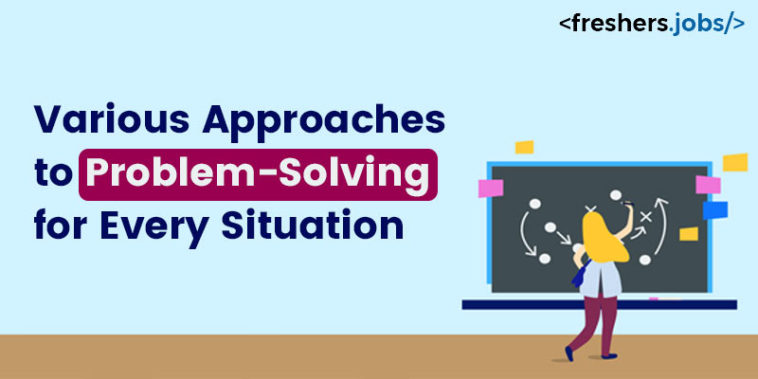Trying different ways to solve problems can help you find good answers to problems at work and in your daily lives. Each field, business, and career has its own set of problems to solve so that employees may use different methods. If you want to know how to solve problems more effectively, this blog will help you to use a few popular problem-solving skills and strategies.
People have problems daily, whether at work or in their personal lives. Given this, once you know how to solve problems the right way, they go from being stressful setbacks to chances to learn and get better. That’s why it’s essential to know how to solve problems differently, no matter what job you have or what business you work in.
This blog will discuss problem-solving strategies and why they are essential.
Very first, let us know what problem-solving strategies are.
A Problem-solving strategy is a plan that helps you find an answer or deal with a challenge. Each strategy for solving a problem has several steps that show you how to solve a business problem or an industry problem. To solve a problem well, you have to figure out what the problem is, choose the right way to solve it and stick to a plan that is made for the problem you are trying to solve in an efficient way to earn high salaries.
Problem-solving techniques are a strategy people use to comprehend their difficulties better and create the best solutions possible. By assisting people in overcoming either the newest or old ways of thinking, they enable people to come up with more creative ideas.
The different types of problem-solving strategies
Here are a few steps or tips for solving the problems or problem-solving method.
Identify the problem
You can discover specific components to develop a strategy to address challenges by taking the time to define a potential obstacle. You can determine how extensive a problem might be and what techniques to implement for a resolution by breaking down different aspects and possible remedies.
To address the immediate problem of being understaffed, a company with a high employee turnover rate, for example, would concentrate on promptly acquiring new personnel. If HR took the time to characterize the problem, they could understand that their onboarding process would make it easier for new hires to integrate into the workplace culture. With this information, the hiring manager may devote more effort to creating a more efficient and friendly onboarding procedure to boost employee retention.
Make the problem visible
If you are personally connected with a problem or scenario, it could be difficult for you to understand its full breadth. In these situations, envision the problem by giving each component its amount of attention.
Create an illustration of the problem
While visualising the problem can be useful, it might be simpler to comprehend a more complicated situation if you can see it. To assist you in illustrating the problem-solving strategies, try creating a picture or a diagram. For example, you might demonstrate various parts of this process to help you identify potential areas for improvement if you want to increase how quickly your team can produce and market a product.
For the latest job openings, You can tap into freshers jobs in Chennai to land your dream IT jobs.
Dividing the problem into smaller parts
Dividing more significant problems into more manageable components or steps could be beneficial. This lets you concentrate on fixing each more manageable problem component separately. Determine the prerequisites for problem-solving skills in the workplace.
You might ask yourself what you want to achieve and what challenges you face. Make a list of all the pertinent tasks that come to mind. Next, arrange each step by listing each in the order of when it must be completed. Divide the list once again by giving each team member a different task.
Rephrase the problem
Consider reframing the problem if it seems intractable. For example, if the company you work for wants to produce a particular product but needs more resources, you may reframe the problem by determining why the company wants to create this product in the first place.
You might find a lot of consumer demand for this product, so your company wants to develop it. Identifying another product with strong consumer demand that your firm has the resources to produce is more viable than concentrating on how the business can make that product.
Gather and arrange data concerning the problem
A specific activity could result in a problem that, over time, reinforces itself for problem-solving techniques. You can also find if there is an underlying pattern by gathering data regarding the situation and putting it into a chart, table, or list.
For example, you might gather information from consumers who have reported problems with their laptops during the previous year if you want to forecast the lifespan of a laptop that a company manufactures. Then, to determine the typical lifespan of a laptop, use a chart to classify the age of the laptops and the severity of the problems the customers reported.
Perform in a reverse manner
Working backwards is sometimes the best method to tackle a problem-solving method. This can be useful if you must reproduce specific occurrences to identify the primary source of a problem. For instance, a car company might aim to create a vehicle that is superior to the most recent model from a rival. They might achieve this by researching the development process of their rival’s car through reverse engineering. Then they can imitate the actions taken by their rival to produce a brand-new, better vehicle.
Apply your prior knowledge
Consider whether you have ever encountered a circumstance comparable to the one you are currently facing. You can make links between various situations. Consider how you handled the previous possibility and apply those strategies to the problem you are attempting to tackle.
For example, a corporation attempting to sell a new clothing line can consider marketing strategies they have previously employed, including magazine adverts, influencer campaigns, or social media commercials. They can develop a successful marketing strategy by looking at the successful systems.
Invite a facilitator
Using a facilitator can improve productivity and mediate collaboration when working on a challenging topic with other individuals for problem-solving steps. Your group can stay on task, record the process, and have more meaningful conversations with the support of an objective third person. To assist you in coming up with better solutions, think about inviting a facilitator to your next group discussion.
Think about using the trial-and-error method
The trial-and-error method may be helpful if you choose the optimal answer for a problem-solving strategy with several possible solutions. Make a list of probable answers, then test each one at a time. Make notes as you go so you have something to refer to after finishing your trials. Then decide on the best course of action using this information.
Create a choice matrix for the assessment
If you devise several solutions to a problem, choose the best one. Because it enables you to rank potential solutions, a decision matrix can be a great tool to assist you in approaching this task.
In handling every situation and being a good problem solver, you can tap for recent openings from CGI jobs for freshers.
Practicality Effectiveness
Once you have chosen which elements to include, use them to rank each potential response by giving each one a weighted value between 0 and 10. For example, one solution might get a ten on the timeliness factor because it satisfies all the criteria, whereas another would only get a 7.
Add up the total number of points each prospective answer received after you have ranked them all according to these criteria. The solution that gets the most points should satisfy the most crucial requirements.
Ask your friends for advice
Getting feedback from your peers might introduce you to fresh viewpoints and original solutions for problem-solving strategies. There may be varied experiences, ideas, and essential skills that friends, relatives, or coworkers offer to assist you in finding the best solution.
Asking a wide range of coworkers or peers what they would do in your position is something to consider. Even if you decide not to use one of their recommendations, talking with them may help you organize your thoughts and find a different answer.
Disengage from the problem
Consider taking a brief break from the problem you are working on if a solution is not required soon. This can be done symbolically by putting the issue on hold for a few days until you are ready to tackle it again or physically by going for a walk to help clear your thoughts. When you return to the problem, you may feel more energized and focused if you give yourself time to rest, work out, and look after your well-being as problem-solving skills to land your dream freshers jobs.




